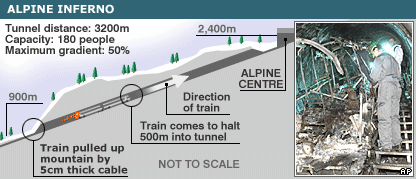The Weekly Reflektion 05/2025
Major Accidents are still a feature of our lives. Disasters are being reported from all over the world. Fires are raging, planes and trains are crashing, buildings are collapsing, dams are bursting, all with tragic consequences. The headlines of course do not give any indication of whether we are getting better, but they do remind us that despite all our efforts to prevent Major Accidents, we still need to prepare people for what to do when it all goes wrong.
How will your people react when a disaster occurs

On 11 November 2000, a fire in the tunnel of Gletscherbahn Kaprun 2 funicular in Kaprun, Austria, killed 155 people. Most were skiers on their way to enjoy the slopes on the Kitzsteinhorn glacier.
The railway was opened in 1974, and the track was 3,900 metres long with 3,300 metres inside a tunnel. The train ascended and descended the 30-degree slope at 25 km/h. Two trains ran simultaneously on a single track, with a section halfway allowing them to pass each other. A motorized winch drove the trains. Therewas a low-voltage electrical system, with 160-litre hydraulic tanks on board for the brakes and doors, and a conductor. Each train had four passenger compartments giving a total capacity of 180 passengers, and a conductor’s cab at each end; the conductor switched end as the train travelled up and down.
At about 0900 hrs. on the day of the accident the train unexpectedly halted 600 metres into the tunnel. Some minutes later the conductor reported a fire to the control centre. He also reported that he couldn’t open the hydraulically operated doors. The conductor then lost contact with the control centre because the fire had burned through a 16kV power cable running alongside the track, causing a power blackout throughout the ski resort.
The fire started in the conductor’s cabin at the rear of the train. A design fault caused the unit to overheat, in turn causing the mount for the heating element to break off and it caught fire. A slow leak of flammable hydraulic fluid was ignited which melted the fluid lines, further feeding the flames. The loss of hydraulic pressure applied the brakes (which are kept open by hydraulic pressure) and disabled the hydraulically operated doors. The fire quickly spread and the chimney effect inside the tunnel escalated the fire and filled the tunnel with toxic smoke. Eventually the conductor managed to open the doors and he and most of the passengers that were still alive started to climb up the stairs to escape the fire. They all died of asphyxiation. Twelve passengers in the rear of the train managed to break a window with ski poles and they escaped the train. One of these passengers was a volunteer fireman and he led the passengers downwards, past the fire itself. That is, they had to move towards the flames to escape. This saved their lives.
The conductor and a passenger in the descending carriage also died of smoke inhalation. When the smoke rose into the Alpine centre2,500 m above, two workers alerted employees and customers and escaped via an emergency exit. They left the exit doors open, which contributed to the chimney effect. Four people in the centre were also overcome by smoke and three died. Firemen managed to revive one of them.
If we want to influence how people will react in an emergency situation, we need to train them and expose them to realistic scenarios. The objective of the training is that they do the right things automatically and do them well.
